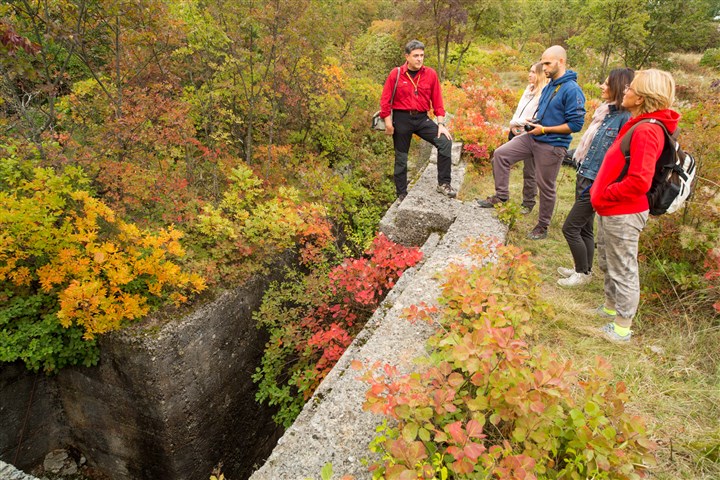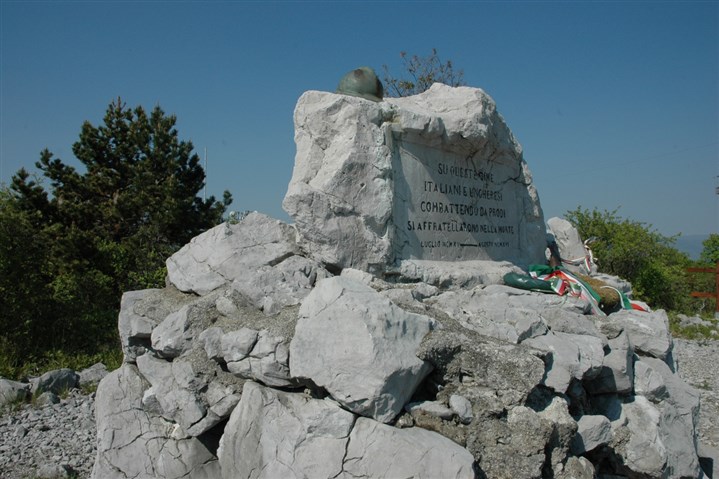Mount San Michele, in the northern part of the Isonzo Karst just a few kilometres from Gorizia, features an evocative journey through history and nature. Thanks to a series of itineraries that are very accessible and easy for everyone, you can discover the buildings and monuments that were built on the slopes and on the four peaks of this Karst relief dating back to the First World War.
Famous thanks to the poems of Giuseppe Ungaretti, who was stationed and fought here for several months, Mount San Michele was the scene of fierce battles on the Isonzo Front, especially during the first year of the conflict. The peak, defended by Hungarian troops, was crucial for the defence of the front and the city of Gorizia in particular. Italian soldiers attacked this 275-metre-high ridge several times with catastrophic results, especially during the Second and Third Battles of the Isonzo. It was only in August 1916, during the Sixth Battle of the Isonzo, that there was a breakthrough with the conquest of the mountaintop.

A STRETCH OF THE TRENCH DELLE FRASCHE ON THE SAN MICHELE SLOPES. HERE THE FIRST THREE BATTLES OF THE ISONZO TOOK PLACE IN THE SUMMER-AUTUMN OF 1915.
The ideal starting point for this itinerary is the "Area delle Battaglie” (the Battle Area), which can be reached from the town of Sagrado by following the signs leading to the top of the mountain. After crossing the Ungaretti Park and the Castelvecchio Estate, and proceeding for roughly 2 kilometres, a sign and a small car park on the right provide an opportunity to stop and discover the "Trincea delle Frasche" trench, the Memorial of the Sassari Brigade and the Filippo Corridoni Memorial.
Back on your vehicle, continue uphill and in less than five minutes you will reach San Martino del Carso This small hamlet in the municipality of Sagrado is now surrounded by the tranquillity of the Karst, but in 1915 it was right on the front line. Completely destroyed by bombing, it became famous throughout Italy (and beyond) thanks to the poetry of Giuseppe Ungaretti.
His poem of the same name can be read in Piazza della Fontana, where you can resume your journey, not before visiting the small museum run by the local Speleological Association. Following the signs for the cemetery, turn left into Via Vallone and then right into Via Bosco Cappuccio in order to reach, on a slight incline, the Memorial of the 4th Honved Regiment. Return to the asphalt road. The entrance to CAI Trail No. 73 is on the left, a short distance from this site. This is the start of the (very easy) climb to the Open-air Museum of Mount San Michele.
At the first junction, turn left (following the signs for the Alpe Adria Trail) and, after passing the remains of the Italian trench, which was the site of the first chemical attack launched on June 29 1916, you will reach the open-air museum in about 10 minutes.
From here, you can continue either to the left or to the right, as both paths lead to the impressive Memorial Stones Trail, which winds around the four peaks of Mount San Michele.
However, we recommend that you turn right instead of going up to Height 3, and continue towards Height 2, where you will arrive at the entrance to the Schönburgtunnel. Turning back towards Height 3, head right following a section of cemented track, walking alongside the Gun tunnel of the Third Army, a large underground structure used by the Italian army.
You will then reach the Main Square, from where you can enjoy a breathtaking view of the Collio region and Gorizia. From here you can also visit the new Virtual Museum of the Great War, a true masterpiece that combines historical information and virtual technology.

THE MONUMENT OF PEAK 3 RECALLS THE ENORMOUS SACRIFICE OF THE ITALIAN AND AUSTRIAN SOLDIERS
AS AN ALTERNATIVE OPTION
For visitors who only plan to visit Mount San Michele or prefer to travel by vehicle from San Martino to the summit, it is possible to follow Via Zona Sacra, which starts from Piazza della Fontana and leads directly to the square with the Virtual Museum. In this case, therefore, the tour can start directly from there and then continue as described above.
Once outside, continue to the left and in less than a minute a path will take you up to Height 3, the (symbolic) heart of this open-air museum. Descend on the same slope, take the Memorial Stones Trail once again and, after passing by the Austrian cave of General Lukachich, return to the start of the itinerary that leads back to San Martino.


